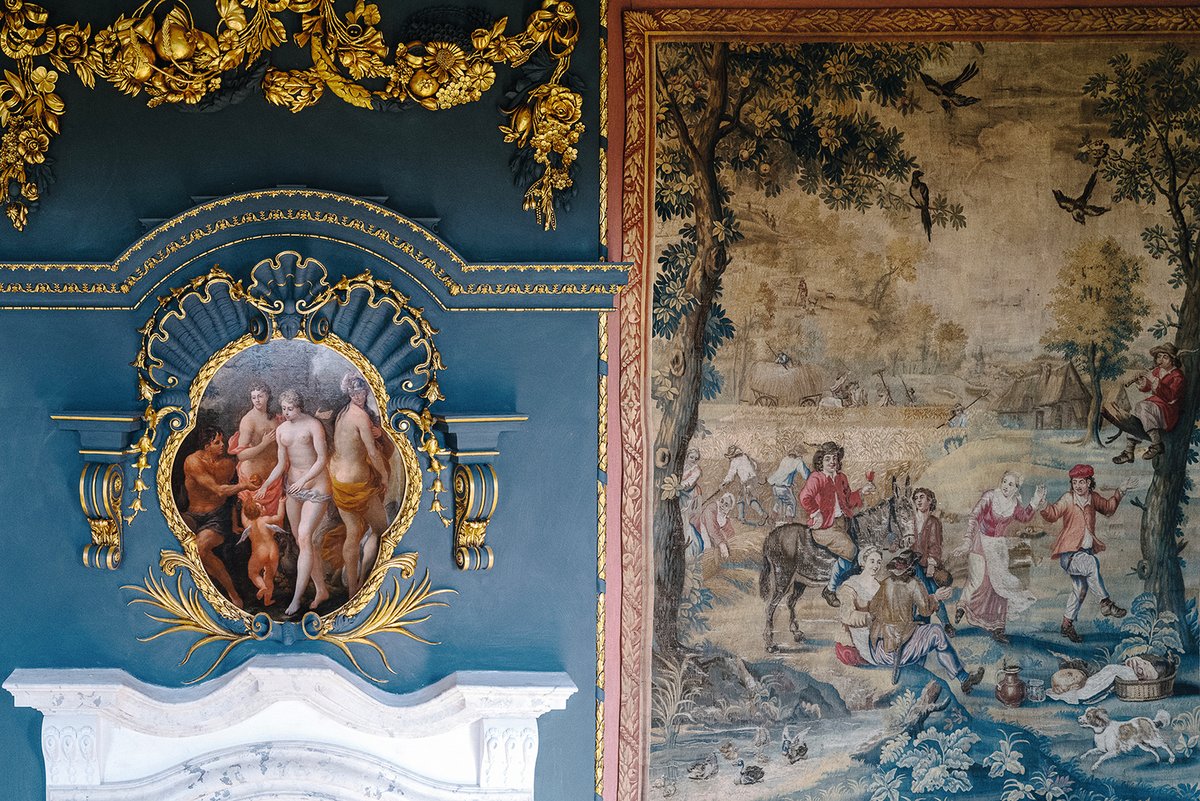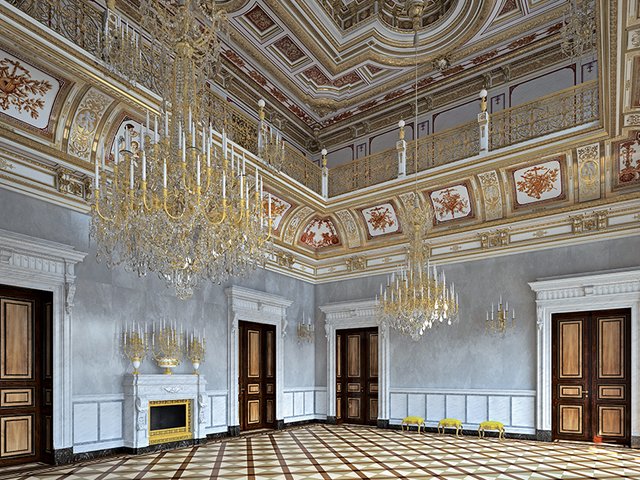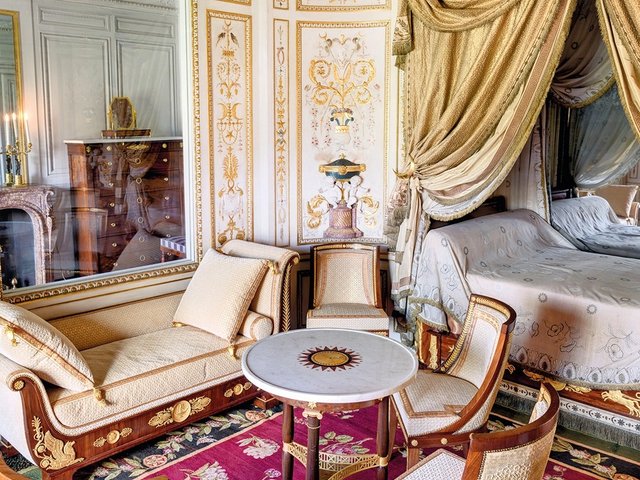The Tapestry Drawing Room at Castle Howard, near York, looks immaculate; with a flowery carpet laid on broad floorboards and gilded plaster branches framing a Judgment of Paris by Marco Ricci, it is flanked by splendid tapestries of the four seasons woven for the room in 1706.
It was a room Nick Howard’s grandparents enjoyed, but he had only known it as a scorched shell. Howard, whose family has lived in one of the most dramatic stately homes in England for three centuries, now promises to find a quiet evening, take a book, and sit down by the brand-new fireplace to relax and enjoy the space.
A little dog scampers across the tapestry to the left of the fireplace, the vertical seams revealing that he was once chopped out of the wintry landscape when the four tapestries were cut down to fit a different room—one of several reshuffles around the huge house. The Howards famously never throw anything out (though there have been regular consignments to auction rooms) and the missing strips were found rolled up in the attic, the original bright colours preserved.
The tapestries were woven by John Vanderbank, a Flemish immigrant who became the leading and most expensive weaver in early 18th-century London. Based on scenes by David Teniers, they show sowing, hay making, harvest and a particularly jolly winter scene with skaters and a fancy sledge being pushed across the ice.
After restoration by Alison Stanton in her Northamptonshire studio, the tapestries fit perfectly back into their original space. They also needed cleaning, strengthening and many splits repaired with Stanton’s near invisible stitches.
They were saved by their moves around a house constantly evolving and undergoing redecoration. In 1940, when the house was leased as a girls’ boarding school, what began as a small chimney fire roared through the building, gutting an entire wing and destroying one of its greatest architectural treasures—John Vanbrugh’s painted dome towering over the central hall.
The tapestries, hanging in a room untouched by the fire, survived while their original home was destroyed. Howard remembers himself as an excited child racing through rooms with boarded-up windows and ceilings open to the temporary asbestos roof.
Planning objections
The decision to recreate the room was controversial. Although planning permission was granted by the Ryedale District Council in 2022, objections were lodged by both the Georgian Group and the Society for the Preservation of Ancient Buildings. They argued that the gutted room told the story of the fire, a major event in the building’s history, while there was no solid evidence of how the room originally looked—particularly the imposing fireplace, for which no original drawings survive—although archive photographs record the early 20th-century appearance of the room.
Chris Ridgway, the head curator at Castle Howard since 1984, rejects these arguments. “The fire was a huge part of the history of this house, but we have no shortage of fire-damaged interiors, thank you very much. If you want to read the story of the fire, we can show you an entire wing. The story doesn’t have to be told in the tapestry drawing room. We may have no original plans for this room, but we do have an absolutely vast archive. And crucially we do have the most important single feature of the room, the tapestries specially woven for it.”
The lost room was the first in a procession of state rooms, among the earliest and grandest parts of the house commissioned in 1699 by Charles Howard, third Earl of Carlisle. He returned from the Grand Tour of Europe full of ideas for an English baroque palace, and gave the job to his friend Vanbrugh, a startling choice given that he had never built anything and was far better known as a dramatist. Vanbrugh brought in another remarkable architect, Nicholas Hawksmoor.
In the 20th century, George Howard never expected to inherit, but having lost two brothers in the Second World War, he returned from the fighting to reclaim his scorched mansion.
‘The mad major’
“What he did was extraordinary,” Nick Howard says of his father. “He was advised to pull down the ruined wing and consolidate the rest, but instead he decided to move in with his family, live here and restore. The locals called him ‘the mad major’.”
His parents spent the rest of their lives working to restore the house, opening it to the public in 1952 and rebuilding the great dome in the 1960s. A major injection of funds came in 1981, as a key location in the world-famous television adaptation of Evelyn Waugh’s 1945 novel Brideshead Revisited—apart from the fee, which rebuilt the Garden Hall, visitor numbers shot up and have stayed robust, boosted by regular large and small screen appearances, including in Bridgerton.
The work on the room—just completed in time for the new season opening, along with major restoration and redisplays of the Long Gallery and Great Staircase—is led by the architect Francis Terry, with the designers Remy Renzullo and Alec Cobbe, and specialist contractors including Philip Gaches for plasterwork; Houghtons of York for joinery, including beautiful new doors; Hesp Jones & Co for decoration; Mark Fitzgerald for furniture; and Clunie Fretton for carving.
Howard declines to reveal the cost. While watching three different sets of specialists putting finishing touches to the room, he insists “we haven’t totted it up yet”. However, the work was partly funded by the auction at Sotheby’s of a pocketful of tiny animals, including a bloodstone anteater with diamond eyes—gemstone masterpieces by Fabergé acquired by his father.
“I was very sorry to see them go,” Howard says. “But they only very occasionally came out to sit on the table at dinner parties, most of the time they just lived in a safe.”
The work never ends. The gutted wing, for instance, remains a concern. “We’re thinking about a white wall gallery space, but it’s very early days,” Howard says. And then there is the astonishing, Grade 1-listed mausoleum, designed by Hawksmoor in 1729, housing generations of Howards and sitting reproachfully on its hill in the park. The 18th-century wit and connoisseur Horace Walpole said it was so splendid “it would tempt one to be buried alive”, but it remains one of the most important buildings on the Historic England Buildings at Risk register.
“I’m not going to have the mausoleum fall down on my head, not on my watch,” Howard says, “but that’s for another day.”
• Castle Howard is open daily until 31 October. The park is open all year round




